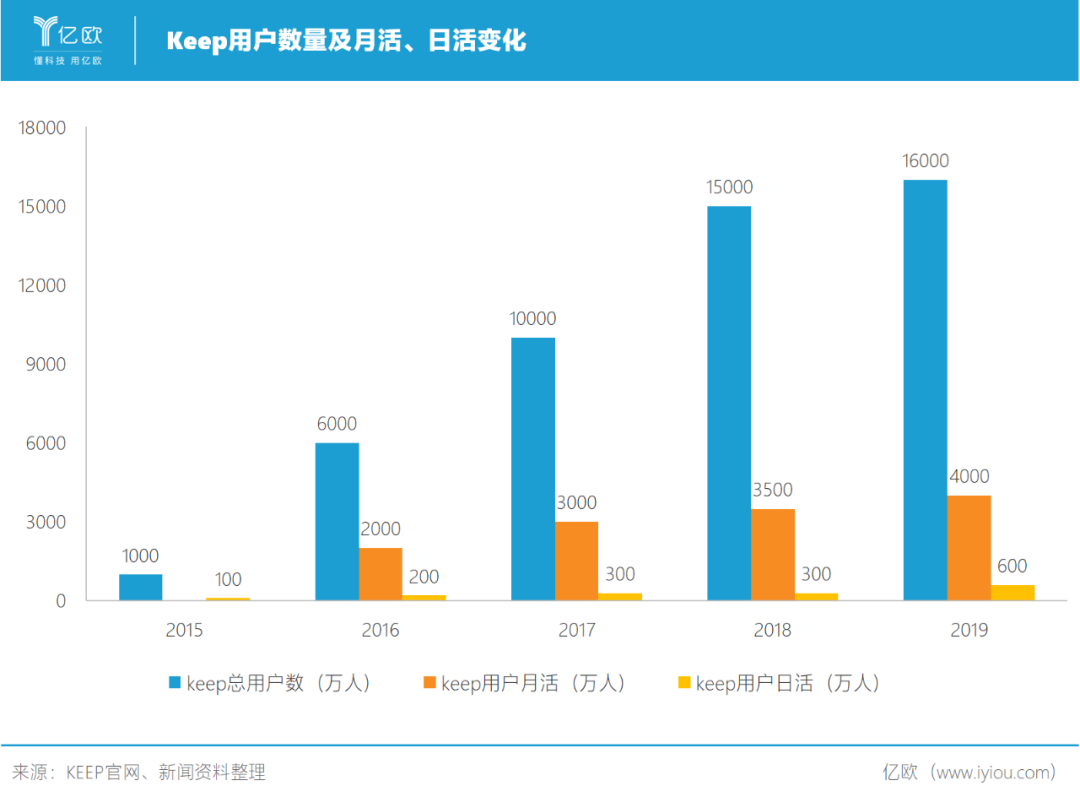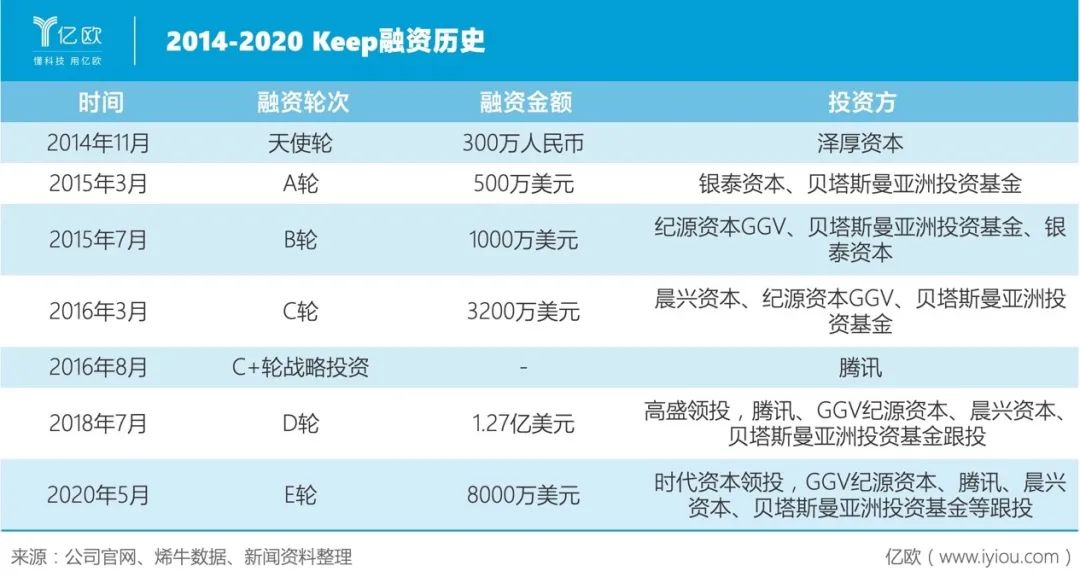Despite dominating the golden track for Internet fitness, Keep is not easy to run.
Editor’s note: This article comes from the WeChat public account “Yiouyi” (ID: i-yiou) .
Author 丨 张凯伦
Editor Yang Xuran
Core views
1. Internet fitness still has huge space
2. Keep commercialization will be healthier after trial and error
3. Flow thinking restricts Keep ’s profitability, but its prospects can still be expected
On May 19, the sports technology company Keep officially announced that it will complete a $ 80 million Series E financing early this year. This fitness app, which has been online for only five years, continues to maintain the leading position in the domestic market.
At present, Keep has completed a total of seven rounds of financing, with a cumulative financing of more than 250 million US dollars, making it the most valuable company in the Internet fitness field.
Keep continued to expand after receiving investment in 2016, but the actual results were not satisfactory. A variety of explorations in commercialization have made it increasingly bloated. At the same time, a series of problems have occurred at the user level. Eventually, at the end of 2019, large-scale layoffs have occurred.
Although it has dominated the golden track of Internet fitness, it has been integrated into the Keep of the E round, and it is not easy to run.
200 million user market
The birth of Keep coincides with the good years of Internet entrepreneurship, with new users, free, capital-driven subsidies overwhelming.
Before that, there were sports apps such as “Goodong” and “Yue Running Circle” on the market, but after Keep went online, the number of users quickly rushed to 5 million, leaving their opponents far behind.
According to investors Goldman Sachs, Keep is optimistic about Keep “becoming the leading sports brand of the younger generation’s lifestyle.”
Sports social attributes are one of Keep ’s most important weapons in defeating other sports apps.
Keep created a discussion square with “sports” as the core for users on the APP, and users can output opinions. Through rankings, challenges, sports stickers, flag sports records, punch cards, etc., old users and active users can share to guide new users and associate with them.
The participation of celebrities and KOL users has also played a role in social suggestion and participation; offline interactive platform KeeplAnd just happened to make up for the vacancy in the real social scene.

Keep user growth
Before fitness, communication needs during fitness, and display needs after fitness are the foundations of Keep ’s social fitness model. As of now, Keep users have reached 200 million. Such a user base means huge business value.
The 2019 Global Sports and Fitness Economic Report shows that the penetration rate of China’s fitness population in 2018 is 0.8%, that is, among 100 people, only 0.8 people may have fitness consumption habits. Although the average is 0.8%, the penetration rate of first- and second-tier cities such as Beijing and Shanghai has reached about 5% to 6%.
This means that there are still many consumer behaviors that have not been cultivated, and there is still huge room for growth in the domestic fitness market.
In terms of profitability, Keep sports consumer goods sales are expected to exceed 1 billion and grow steadily at an annual rate of 300%. Among them, the revenue of smart hardware products in 2019 increased by 177% year-on-year, and the annual revenue of online business in 2019 increased by 286% year-on-year.
Time Capital Investment team said that Keep has a wider applicable population and a larger market in China than Peloton, a US listed company. “This heavy investment in Keep is not only optimistic about China’s sports market, but also an important investment in the field of consumption upgrading.”
Radical layout commercialization
At the end of 2015, Wang Ning, the founder of Keep, said in an interview that if Keep cannot transform into a profitable Internet company in 2016, there will be no chance for Keep.
At the beginning of his business, he adhered to the belief of “building high walls, accumulating food, and slowly becoming king”. But after getting the D round of financing, he began to expand vigorously and explore commercialization in all directions.

Keep ’s previous financing
This is something almost all Internet companies have to do before going public. Keep must also use income growth to prove to the capital market that his business model is feasible and sustainable.
Keep chooses to extend from online to offline, and from software to hardware.
In 2016, Keep began to go online to sell sports goods. However, after a period of operation, the e-commerce business has achieved mediocre results, with few sales of SKUs, and the low repurchase rate of sports goods, which cannot fully support commercialization.
In early 2018, Keep opened the first offline gym Keepland in the Beijing China Trade Center.
In 2019, smart hardware treadmills, sports bracelets and walking machines were launched. Compared with Xiaomi and other professional hardware manufacturers, the timing of Keep hardware coming in is not too early. The official price of the bracelet is 169 yuan-the 100 yuan level bracelet market has always been a fierce fight in the Red Sea.
The ideal state of Keep intelligent hardware is to use the built-in module to obtain training data and remind users to adjust the training rhythm and speed in real time-just like a private teacher who monitors body data in real time.
Before the bracelet, Keep has released a walking machine. According to its published data, the Internet connection rate reached 92%, and more than 58% of users per week combined with online content to complete each run.
In addition, Keep also tried the brand new “KeepLite Light Food”. Although there have been previous reports that the launch of the light food and Keepland business has not yet seen a return, but keep also responded, sports products, advertising, APP members and Keepland sports space, these four parts have achieved profitability in 2019.
In view of various considerations such as warehousing, logistics and after-sales, the Keep team has not invested much in e-commerce. In Wang Ning’s view, e-commerce business has to be taken out to become Keep’s first-class entrance “at least for some time.”
Traffic thinking is difficult to realize
Frequent commercialization exploration has made Keep ’s model increasingly heavier, and pressure to question its business model has followed.
The problem really exists. In October 2019, Keep conducted a staff optimization and business callback, involving 10% -15% of Keep’s total 800 employees.
At the time, Keep responded to this round of optimization: “Optimizing the talent structure to improve organizational efficiency is a necessary item for the company’s long-term development management.” It can be said that it basically conforms to the facts. In the stage of rapid growth, it is reasonable to shut down unverified businesses in a timely manner and iterate team members. After all, no CEO can ensure that every business line can succeed.
Today, Keep was once again blessed with capital, marking that capital basically eliminated doubts about its period of major adjustments.
Traffic thinking during Keep’s development is a double-edged sword for Keep. On the one hand, a large number of free basic content and services can bring traffic, on the other hand, it also affects its income to a certain extent.
After trying to develop user habits, it uses e-commerce, paid content, hardware, offline gyms and other “big ecology” to realize all-round monetization of the users in circles. This makes sense logically, but in reality At the operational level, there are still no small challenges.

Keep user growth
For users who are used to Internet wool, it is not easy to convert into paying users. In 2018, Keep ’s revenue from content realization is about 20 million yuan. Looking at the volume of 35 million monthly active users, the situation is not optimistic.
Second, fitness products are far more than Keep, and industry competition has been fierce. More apps are not as widely watched as Keep, but they will also be part of Keep’s users.
The success of any product is inseparable from effective operations, especially Keep, a company that has just experienced “barbarous growth”.
Recently, Keepland announced the closure of its three stores, namely Jing’an Joy City Store, Changfeng Joy City Store and Jinqiao Store, which are all their stores in Shanghai. Earlier, in December last year, the Keepland Beijing Damei Store was closed.
Keepland now has only 10 stores, all located in Beijing.
Ending
After the twists and turns, Keep has explored some feasible business models online and offline, and has also made some achievements:
Sports category is the largest cash flow. Revenue in 2019 is expected to reach 1 billion yuan, more than half of total revenue. Among them, smart hardware accounts for 35%, sports equipment accounts for 40%, and food accounts for 25%. After the sports category, the largest proportions of revenue contribution are members (paid online), advertising and Keepland.
But this is obviously not enough for a star company that has just completed 80 million US dollars of E round financing. When a platform can affect the lives of hundreds of millions of young peopleIn live mode, it still has more potential profit opportunities to explore.
After all, according to Wang Ning’s plan, Keep wants to target Nike.